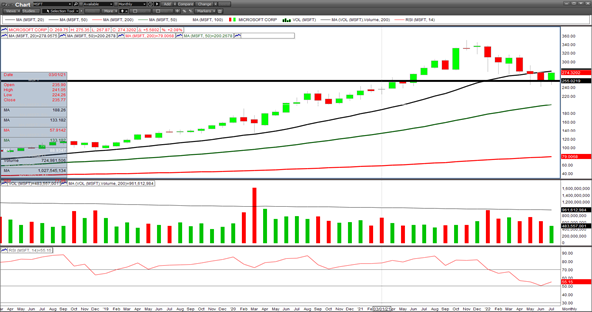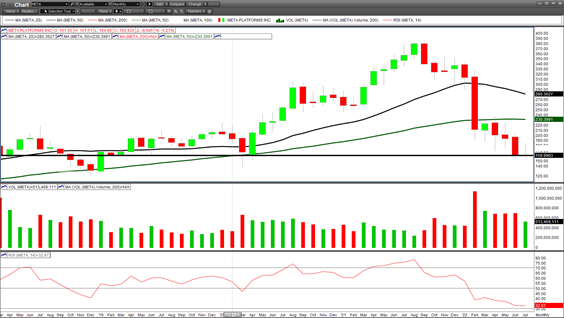It is a busy week in the markets. One-third of the S&P 500 and Dow Jones indices are posting Q2 results over these five sessions.
Did we mention that there is also a Fed decision this week? And we still have earnings from Amazon (AMZN) and Apple (AAPL) after the close.
Market participants try and keep up with the news but it is like drinking water from a fire hose. We will recap earnings highlights and price action over the next few articles. This will be the cliff notes addition to help keep you abreast of key themes emanating from the Q2 reporting season.

Alphabet (GOOG)
Shares of Alphabet were under pressure ahead of its Q2 earnings report. Snap Inc (SNAP) reported a terrible round of earnings the prior week. This led to major concerns around the digital advertising space and lower expectations for GOOG.
The company missed EPS for the second quarter in a row. This marked the first time in over a decade that it missed bottom-line expectations in back-to-back quarters. Revenue growth was only 13%, its slowest growth in the past five years outside of the pandemic-impacted 2Q20 when revs grew +1.3%.
Advertising revenues came in at $56.3 billion which was slightly ahead of expectations. This was up 12% from the prior year period and a slowdown from the 22% growth posted in Q1. The company was up against tough comps as the prior year’s ad revenue growth was an incredible 69% y/y.
YouTube ad revenue was a drag on results as it was only up 4.8% y/y to $7.34 billion. The company continues to feel the competitive presence of TikTok. GOOG is building its YouTube Shorts business to combat the pressure.
Google’s Cloud segment also slowed down as it posted growth of 36% y/y compared to the 46% average over the past eight quarters. It was also short of the 40% growth Microsoft (MSFT) posted in its Azure unit.
Operating Expenses grew 24% to outpace revenue growth. This despite news that the company slowed its hiring process in the quarter. CFO Ruth Porat reiterated the plans to slow hiring on the call which has analysts expecting a further slowdown in expenses.
FX Headwinds impacted the top and bottom line by 4% which is generally in line with what we have seen from multinationals.
Porat warned that tougher comps, macro, and FX headwinds would continue to weigh on results. She said that “uncertainty” would be the best way to describe the economic backdrop.
The results for GOOG can be viewed as better-than-feared at best. It continues to highlight the issues facing digital advertising despite signs that consumer spending remains strong. This will temper expectations around future results.
Shares of GOOG have erased the post-SNAP losses as the broader market finds some bids. This has led GOOG back to its 50-day moving average ($112) which sets up a key test for bulls. GOOG has weathered the storm better as it never relied on Apple’s IoS ecosystem the way others like SNAP and Pinterest (PINS) but it still has to deal with a deteriorating environment.
Investors want to see signs that this environment has improved. This likely leads GOOG into a range-bound trade between $100-120. However, the low end of that range provides significant support. A savvy investor should look to build a position around any moves to the downside of the range.
Microsoft (MSFT)
Microsoft produces a rare bottom-line miss, falling six cents shy of the $2.29 expectations. Revenues grew 12% from the prior year period, well below the 18-22% range, it posted in the prior four quarters.
FX headwinds had a 4-cent impact on the bottom line but the company would have missed expectations on a constant currency basis.
MSFT stated, “In a dynamic environment we saw strong demand, took share, and increased customer commitment to our cloud platform”.
Microsoft blamed the extended production shutdowns in China, a deteriorating PC market, and a withdrawal of spending from Russia as key reasons why it missed expectations. Reductions in advertising spend weighed on LinkedIn and search results.
The Azure cloud business increased 40% y/y which did beat Google. Investors will keep a close eye on Amazon’s AWS results Thursday after the close for another comparable.
Shares of MSFT were under pressure following the results. That sell-off would reverse on the call as the company hit an upbeat tone around its outlook. MSFT stated that demand for its products remained robust. The revenue outlook is calculated to be approximately $49.25-50.25 billion which would be slightly below the $51.4 billion consensus expectations but most view it as conservative and “good enough”.
The commentary around demand eased investor concerns and led to the turnaround. The stock is now pushing higher as it breaks to a multi-month high of $274 in Thursday trade.
This remains a solid haven for investors to park cash as we await further evidence of how the economy evolves under the stress of Fed rate hikes. The $250-255 area remains the line in the sand for shares.

Meta Platforms (META)
The digital advertising slowdown was on full display in the META results. The company posted its first year-over-year revenue decline since it turned public in 2007. Two quarters ago, Meta posted another first when it saw it’s first ever decline in Daily Active Users. These are not the type of “firsts” investors want to see.
Shares of META are down 57% since hitting all-time highs of $380 back in August of 2021. Privacy concerns had been the primary headwind but now we are seeing overall macro concerns weigh heavily on investor sentiment.
The company’s Q3 outlook was below expectations reflecting the continuation of headwinds driven by macroenvironment uncertainty. The midpoint of the outlook suggests the company is in store for another top-line decline in Q3.
Meta did see some success in its Reels platform which will be key for its battle with TikTok. The platform saw a 30% jump in user engagement time in Q2. Revenues were above $1 billion for the first time in the company’s history but this remains a small piece of the $124 billion META generated last year.
While MSFT and GOOG saw a “better-than-feared” reaction to earnings, META has seen further selling pressure. Investors are genuinely concerned that the company will not be able to innovate and change direction.
The one notable for META bulls is that the $160 area continues to hold support. This support level dates back to the early days of the pandemic. If that gives way, sellers could jump ship in search of other opportunities.

We still have two big tech players left with AMZN and AAPL. The early moves suggest investors are willing to step in and buy a disappointing quarter as long as there are some potential returns in the future. GOOG and MSFT were able to establish some signs of hope. META remains a cause for concern for investors, but we will watch to see if support can hold. This would signal that most sellers have already left.



